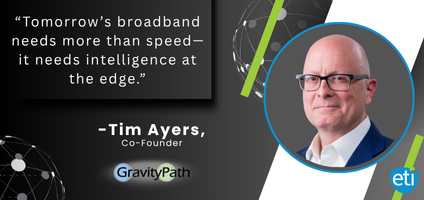
The following summary has been condensed for length and readability. To listen to the full discussion, click here. This episode is sponsored by intelegrate and VETRO FiberMap.
In this episode of The Broadband Bunch, Tim Ayers, co-founder of Gravity Path Partners, shares his perspective on how edge computing, AI, and quantum innovation are transforming broadband infrastructure.
Recording live on the floor of Connected America 2025 at the Irving Convention Center in Dallas, host Brad Hine sits down with telecom veteran Tim Ayers to discuss where broadband is headed—and why edge computing is playing a critical role in that transformation. With over 30 years of global experience across telecom, cloud, and data infrastructure, Ayers brings a seasoned yet visionary take on what’s next.
Connected America brings together a diverse mix of fiber operators, WISPs, public sector leaders, and community broadband stakeholders. It’s the perfect backdrop for a conversation centered on cooperation, infrastructure innovation, and long-term broadband strategy.
Ayers defines edge computing as the process of moving data storage and processing closer to the user—whether that’s a smart home, a factory, or a neighborhood filled with remote workers and gamers. As modern applications demand ultra-low latency and near-instantaneous data transfer, edge computing becomes essential to meet user expectations.
Applications like augmented reality, live streaming, and real-time AI services simply can’t function properly when data has to travel hundreds of miles to centralized data centers. Instead, they rely on edge compute nodes located closer to users. According to Ayers, reducing latency to under 13 milliseconds is the threshold for making digital experiences feel “human”—a vital benchmark in the AI era.
The rise of AI-powered tools, predictive automation, and digital assistants is pushing the broadband ecosystem to rethink its core. AI workloads don’t just need bandwidth—they need smart, distributed compute power that allows for real-time responses.
Edge is becoming the answer to AI’s hunger for low-latency environments. And with quantum computing on the horizon, this need will only grow. Ayers predicts we’ll soon see quantum edge devices becoming mainstream—alongside smart infrastructure that can support their advanced processing demands.
The shift from centralized cloud environments to distributed edge networks will be pivotal for managing these future demands.
One of the most tangible elements of this shift is how physical infrastructure is evolving.
Ayers outlines three types of edge deployments:
Large-scale edge data centers in old telecom central offices or exchanges
Mid-sized regional edge hubs in retrofitted commercial or industrial spaces
Micro edge data centers tucked into office buildings, hotels, or local facilities
These localized nodes allow for data caching and compute power closer to where it’s needed—dramatically improving performance and resiliency. Ayers notes that the shift also addresses persistent infrastructure problems like fiber redundancy and power access, which often hamper large-scale data center deployments.
Ayers makes a strong case that communities and providers must look beyond current needs to avoid falling behind again.
Today’s digital divide is measured in Mbps—but tomorrow’s divide will be about who has access to AI and compute power. Without edge compute capabilities and neutral-host architectures, underserved communities risk being left out of the next phase of digital progress.
He urges municipalities and broadband providers building networks with BEAD or private funding to ensure their infrastructure can evolve to host edge services. This future-proofing is key to enabling everything from digital learning and telehealth to smart cities and autonomous vehicles.
Gravity Path Partners operates at an intersection of telecom and digital infrastructure. Ayers describes the firm’s two core functions:
Sell-side advisory – Helping fiber operators and service providers prepare for M&A, capital raises, and strategic partnerships.
Growth transformation – Assisting companies as they enter new sectors, such as moving from traditional telecom into the data center market.
As edge continues to blur the line between networks and compute, Gravity Path’s work reflects the broader industry trend: convergence. Their clients are increasingly positioning themselves to serve both broadband and cloud-native environments.
Ayers offers a bold prediction: we’re still at the beginning of the edge revolution.
He believes that hyperscale and metro data centers will continue to grow, but edge computing will expand even faster. The demand for distributed, low-latency networks will be fueled by AI, smart devices, autonomous systems, and the eventual arrival of quantum networks.
The future won’t just be about getting a gig to every home—it will be about enabling real-time compute at the edge of the network to support personalized, AI-enhanced digital experiences. That means rethinking infrastructure now, before the next wave of innovation leaves slower movers behind.
© 2025 Enhanced Telecommunications.